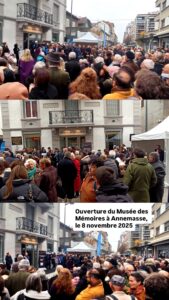THE PAX PRISON — A HIGHLY SYMBOLIC PLACE OF THE RESISTANCE
At the end of December 1942, Italian soldiers occupied Annemasse. They requisitioned a hosiery factory located at 21 Avenue de la Gare and used the basement to imprison political opponents.
But in September 1943, the Italians left and German occupation troops took their place. Soldiers from the “SS Polizei Regiment Todt” set up headquarters at the Hôtel Pax, while the hosiery factory just across the street was converted into a prison.
It became the main prison of the department during the Second World War, with hundreds of people detained there. The prison register lists 736 names, though not all prisoners were recorded. Among them were members of the Resistance and Jewish people — including 39 children.
Some of the prisoners were murdered, others released, but most were transferred to the Montluc Prison before being deported to concentration and extermination camps.
Such was the fate of Mila Racine (Born in Moscow and arrived in Paris with her family in 1926), a young member of the Resistance who saved many Jewish children by helping them cross the Swiss border illegally. Arrested on October 22, 1943, she was imprisoned in the Pax Prison and later deported to the Mauthausen camp, where she died under Allied bombings just a few days before the liberation of the camps.
After Mila Racine’s arrest, Marianne Cohn took over her mission. This young resistant also saved many Jewish children, but she was arrested on June 1 together with a group of children.
The mayor, Jean Deffaugt, managed to secure the release of the youngest ones and offered to help Marianne escape. She refused, fearing reprisals against the children. Tortured, she never spoke, and she was murdered at Ville-la-Grand on July 8, 1944, along with five other prisoners.
FROM THE PAX PRISON TO THE HOUSE OF MEMORIES — A PLACE OF COLLECTIVE REMEMBRANCE
The symbolic transformation of the former Pax Prison into the House of Memories breathes new life into a site steeped in history — a witness to the darkest hours of the region during the Second World War and to the heroic acts of the Resistance.
This redesigned institution will serve to gather and transmit the heritage of Annemasse, ensuring that the memory of those times continues to live on.
A MODERN AND INTERACTIVE MEMORIAL EXPERIENCE
The House of Memories features a 120 m² interpretation center, completely reimagined to offer an immersive and educational experience.
The building’s exterior façade, the only remaining original element, has been carefully restored to its historical appearance, including the reconstruction of the first-floor balcony.
A museum itinerary, supported by modern and interactive scenography, makes the history of the site during the Second World War accessible to all visitors.
Sources:
Annemasse’s official website: https://www.annemasse.fr/


